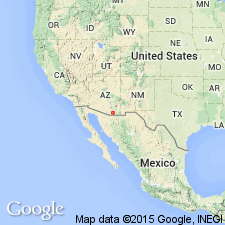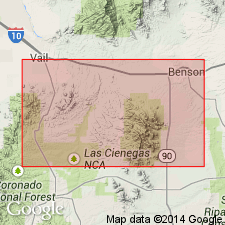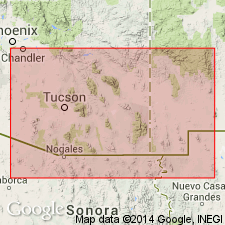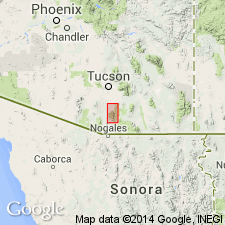
- Usage in publication:
-
- Turney Ranch Formation
- Modifications:
-
- First used
- Dominant lithology:
-
- Sandstone
- Siltstone
- Shale
- Bentonite
- AAPG geologic province:
-
- Basin-and-Range province
- Pedregosa basin
Summary:
First use in published report. Shown in Whetstone Mountains of Cochise Co (Pedregosa basin), Pima and Santa Cruz Cos, Basin-and-Range province, and in Empire Mountains of Pima Co. Overlies Shelleburg Canyon formation (first published use) and underlies Hilton Ranch conglomerate (first published use). Approximately 1,000 feet thick. Composed of coarse- to fine-grained clastic rocks, a repetitive sequence of thin- to thick-bedded sandstone, siltstone and shale. Siltstone and shale are shades of maroon, green, and brown. Some bentonite layers. Scour and fill structures common. Extended to Empire Mountains, AZ, Basin-and-Range province. Is of Early Cretaceous age.
Source: GNU records (USGS DDS-6; Denver GNULEX).

- Usage in publication:
-
- Turney Ranch Formation*
- Modifications:
-
- Overview
- AAPG geologic province:
-
- Basin-and-Range province
- Pedregosa basin
Summary:
Present in the Empire and Whetstone Mountains. Type section in Whetstone Mountains in secs 21, 22, and 27, T19S, R18E. Consists of red siltstone and shale alternating with pinkish-gray, medium to coarse grained, arkosic, and cross-bedded sandstone. Lenses of pebble (chert and quartzite) conglomerate in an arkosic matrix occur locally. Scour and fill structures a few in deep occur at base of some sandstone beds. Conformably overlies Shellenberger Canyon Formation (adopted) and unconformably overlain by rocks of probable Late Cretaceous age, or with angular unconformity by upper Cenozoic gravel deposits. At least 3,200 ft thick in type. Top eroded. Is of Early Cretaceous age.
Source: GNU records (USGS DDS-6; Denver GNULEX).

- Usage in publication:
-
- Turney Ranch Formation*
- Modifications:
-
- Overview
- AAPG geologic province:
-
- Basin-and-Range province
- Pedregosa basin
Summary:
Is formation of Bisbee Group in Santa Rita Mountains (Santa Cruz and Pima Cos, AZ) and Empire Mountains (Pima Co, AZ) in Basin-and-Range province, and in Whetstone Mountains (Pima and Cochise Cos, AZ) in Basin-and-Range province and Pedregosa basin. Overlies Shellenberger Canyon Formation (Albian) with conformable contact. Underlies Fort Crittenden Formation (Campanian) with slight angular unconformity in Santa Rita Mountains. Underlies Fort Crittenden west of north end of Empire Mountains; underlies Salero Formation (Campanian and Maestrichtian) elsewhere in range. Is at least 3,200 ft thick in Empire and Whetstone Mountains; maximum exposed thickness in Santa Rita Mountains is about 1,500 ft. May be younger than any part of Bisbee Group (Lower Cretaceous) in Mule or Huachuca Mountains. Is considered possibly correlative in part with Cintura Formation (Albian) in Mule and Huachuca Mountains. Age is shown to be Albian (Early Cretaceous) on correlation chart (fig. 5).
Source: GNU records (USGS DDS-6; Denver GNULEX).

- Usage in publication:
-
- Turney Ranch Formation*
- Modifications:
-
- Areal extent
- AAPG geologic province:
-
- Basin-and-Range province
Summary:
Extended to Santa Rita Mountains, Basin-and-Range province. Is of Early Cretaceous age.
Source: GNU records (USGS DDS-6; Denver GNULEX).
For more information, please contact Nancy Stamm, Geologic Names Committee Secretary.
Asterisk (*) indicates published by U.S. Geological Survey authors.
"No current usage" (†) implies that a name has been abandoned or has fallen into disuse. Former usage and, if known, replacement name given in parentheses ( ).
Slash (/) indicates name conflicts with nomenclatural guidelines (CSN, 1933; ACSN, 1961, 1970; NACSN, 1983, 2005, 2021). May be explained within brackets ([ ]).

